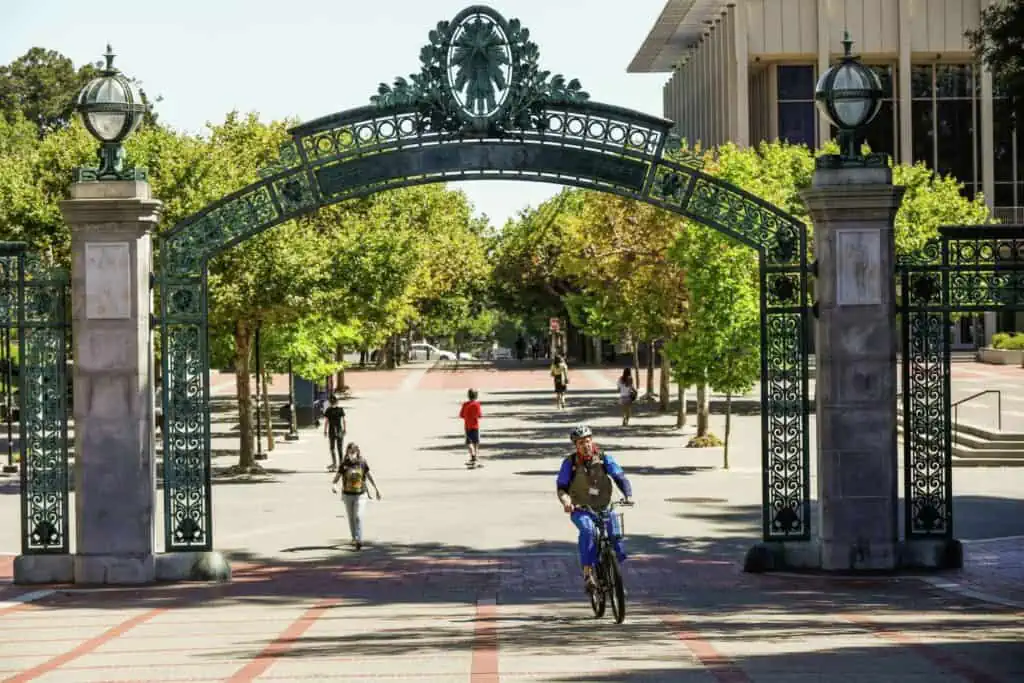Do you have what it takes to get into the University of California Berkeley, one of the world’s best public universities?
This article covered the UC Berkeley acceptance rate for 2023 freshman and transfer students and the most important things they check for when reviewing applications.
Now, let’s get to business.
Is UC Berkeley hard to get into?
Getting into UC Berkeley is relatively hard; of every 100 applicants, only 11 are offered admission. Since most applicants meet the minimum admission requirements, the admission officers look for things that distinguish some applicants, like essays, extracurriculars, accomplishments, etc.
Being a prestigious institution and the oldest school in the University of California system, it receives many applications annually. While most of these applicants are qualified for admission, only the best are selected.
Therefore having a perfect GPA and good enough grades may not cut it. This is why some smart applicants get waitlisted or rejected by UCB. Also, how hard it gets depends on various factors.
Factors like residency, admission path, major, etc., determine how tough the competition will be. For example, as an international student, you should expect your chances of getting admitted to be lower than an in-state student.
Impacted majors, such as computer science, economics, public health, etc., are generally more competitive due to their high demand. While changing majors is feasible at UCB, some majors are hard to change. Your intended Undergraduate Major Adviser can give you some alternatives.
UC Berkeley acceptance rate 2023
The UC Berkeley acceptance rate for the class of 2027 is 11.6%. Of the 125,910 freshman applicants who applied for fall 2023 admissions, only 14,566 students were admitted.
When we compared the freshman admissions data for 2023 to the previous year, UC Berkeley saw a 1.8% decline in first-year applications and a 0.2% increase in the selectivity rate.
Below are the acceptance rates for the University of California Berkeley over the past five years.
| Year | Acceptance Rate |
|---|---|
| 2019 | 16.8% |
| 2020 | 17.5% |
| 2021 | 14.5% |
| 2022 | 11.4% |
| 2023 | 11.6% |
Based on residency, UC Berkeley’s acceptance rate for international students is 5.52%. UCB’s admit rate for out-of-state students is 8.61%, while that of California residents is 14.52%.
International students have the highest yield rate of 53%, followed by 47% for in-state students and 28% for domestic non-residents of California.
Also Read:
- UC San Francisco acceptance rate
- UC Merced acceptance rate
- UC Irvine acceptance rate
- UC Santa Cruz’s acceptance rate
- UC Davis acceptance rate
Transfer acceptance rate at UC Berkeley
The University of California Berkeley transfer acceptance rate for 2023 is 28.9%. The school received 19,334 transfer applications and admitted 5,586 students for the class of 2027. About 92% of these students transferred from California community colleges.

Across all schools in the UC system, it’s normal for the transfer admit rate to be higher than that of freshman admissions. While transferring from a community college might seem hard, saving money is smart.
Even though UC Berkeley saw a significant decrease in the number of transfer applications this year, its transfer selectivity rate increased by 1.9%.
The UC system has an agreement with all California community colleges called the Transfer Admission Guarantee (TAG). The program guarantees admission to six of the nine UC campuses, provided they meet the minimum GPA and course requirements.
However, Berkeley is not part of this TAG program but still strongly prefers students transferring from California community colleges. Transferring could be a viable option for students who cannot gain admission as freshmen or who wish to save money on tuition. And indeed, it’s a more affordable route than directly starting at a four-year university.
UC Berkeley acceptance rate by major
| Major | Acceptance rate |
|---|---|
| Environmental earth science | 39% |
| Environmental economics & policy | 37% |
| Geography | 27% |
| Conservation & resources studies | 48% |
| Environmental science | 12% |
| Society & environment | 33% |
| Architecture | 21% |
| Landscape architecture | 16% |
| American studies | 58% |
| Chicano studies | 26% |
| Gender & women’s studies | 20% |
| Integrative biology | 27% |
| Molecular & cell biology | 26% |
| Microbial biology | 20% |
| Molecular environmental biology | 25% |
| Business administration | 4% |
| Media studies | 26% |
| Computer science | 4% |
| Data Science | 15% |
| Chemical engineering | 37% |
| Bioengineering | 21% |
| Civil engineering | 27% |
| Electrical engineering – computer science | 10% |
| Mechanical engineering | 16% |
| Art | 42% |
| Film | 29% |
| History of art | 53% |
| Music | 41% |
| Theater and performance studies | 52% |
| Chinese language & literature | 16% |
| Japanese language & literature | 43% |
| Linguistics | 17% |
| Cognitive science | 9% |
| Global studies | 17% |
| Interdisciplinary studies | 50% |
| Nutritional science | 10% |
| Legal studies | 20% |
| English | 43% |
| History | 19% |
| Philosophy | 51% |
| Applied mathematics | 31% |
| Mathematics | 26% |
| Statistics | 35% |
| Chemical biology | 13% |
| Chemistry | 20% |
| Physics | 40% |
| Psychology | 6% |
| Public health | 15% |
| Anthropology | 15% |
| Economics | 22% |
| Political economy | 26% |
| Political science | 21% |
| Sociology | 46% |
Note: The data above is for transfer students only.
University of California Berkeley Admission Stats

Gender
| Female | 52.2% |
| Male | 46.8% |
| Not reported | 0.5% |
| Genderqueer | 0.3% |
| Trans Male | 0.1% |
| Trans Female | 0.1% |
Residency
| California resident | 65.5% |
| Nonresident international | 15.0% |
| Nonresident domestic | 12.5% |
| Unknown | 7.0% |
Ethnicity
| African American | 3.8% |
| Hispanic/Latino(a) | 18.8% |
| American Indian | 0.4% |
| Pacific Islander | 0.2% |
| Asian | 38.9% |
| White | 20.8% |
| Domestic unknown | 4.0% |
| International | 13.1% |
GPA and test scores of middle 25%-75% students
| High School GPA | 4.15 – 4.29 |
| ACT Composite Score | 30 – 35 |
| ACT English Language Arts | 28 – 32 |
| SAT Evidence-Based Reading & Writing | 660 – 750 |
| SAT Mathematics | 680 – 790 |
| SAT Essay | 16 – 19 |
UC Berkeley GPA Requirements
As a freshman applicant, you need a 4.20 weighted grade point average for admission into UC Berkeley. An average admitted first-year student has a weighted GPA of 4.22.
Meanwhile, applicants transferring from a community college to UCB need a minimum GPA of 3.81 on a 4.0 scale to be considered competitive. Also, UC Berkeley does not offer transfer students a Transfer Admission Guarantee (TAG) program.
Before UC schools started ignoring standardized test scores, applicants used to complement their below-average GPA with their SAT/ACT scores; the only way to do that now is by taking challenging courses such as AP/IB classes to get additional points.
For those who fall short on GPA, it’s advisable to focus on other parts of the application, specifically the personal statement. You should highlight personal growth, resilience, and preparedness for the university environment.
UC Berkeley Admission Requirements 2024
Remember that UC Berkeley receives x10 the number of applicants it can admit and hence uses a holistic selection process when reviewing applications. To get admitted to UCB, your academic and non-academic profile needs to be solid.
Being one of the most selective universities in the nation, anyone planning to study at UC Berkeley must be above average and meet the minimum admission requirements. This is not restricted to only being a class topper.
As a freshman applicant, your academic performance is demonstrated by:
- Your weighted and unweighted UC grade point average (calculated using 10th and 11th grade UC-approved courses only)
- Your planned 12th-grade courses
- Your pattern of grades over time
- The number of college preparatory, Advanced Placement (AP), International Baccalaureate (IB), honors, and transferable college courses you have completed
- Your level of achievement in those courses relative to other UC applicants at your school
- Your scores on AP or IB exams and SAT subject exams
On the other hand, transfer students must have completed the following before applying to UCB:
- Completion of general education/breadth requirement
- Minimum 60 UC-transferable semester units (90 UC-transferable quarter units)
- Please note that every course offered at your institution is not UC-transferable
- Overall minimum GPA of 3.0 in all transferable college-level coursework
- Lower Division Major Preparation Courses
The admission officers are looking for three major things; passion, persistence, and a desire to give back. Your volunteer activities and non-academic achievements primarily show the last part.
Last, but not least, try to be genuine when answering the personal insight questions and revise them before submitting your UC application.
Regarding admissions, the University of California Berkeley will continue to get more selective every year. We reviewed the UC Berkeley acceptance rate, admission requirements, and statistics.
Feel free to use the comment section if you have any questions or suggestions. Don’t forget to share this post with others 🙂
Resource:

Sam is a brilliant young Nigerian biochemistry student and an aspiring entrepreneur. Despite facing many challenges, he has never lost his passion for learning and drive to make a difference in the world. Read more about him here.